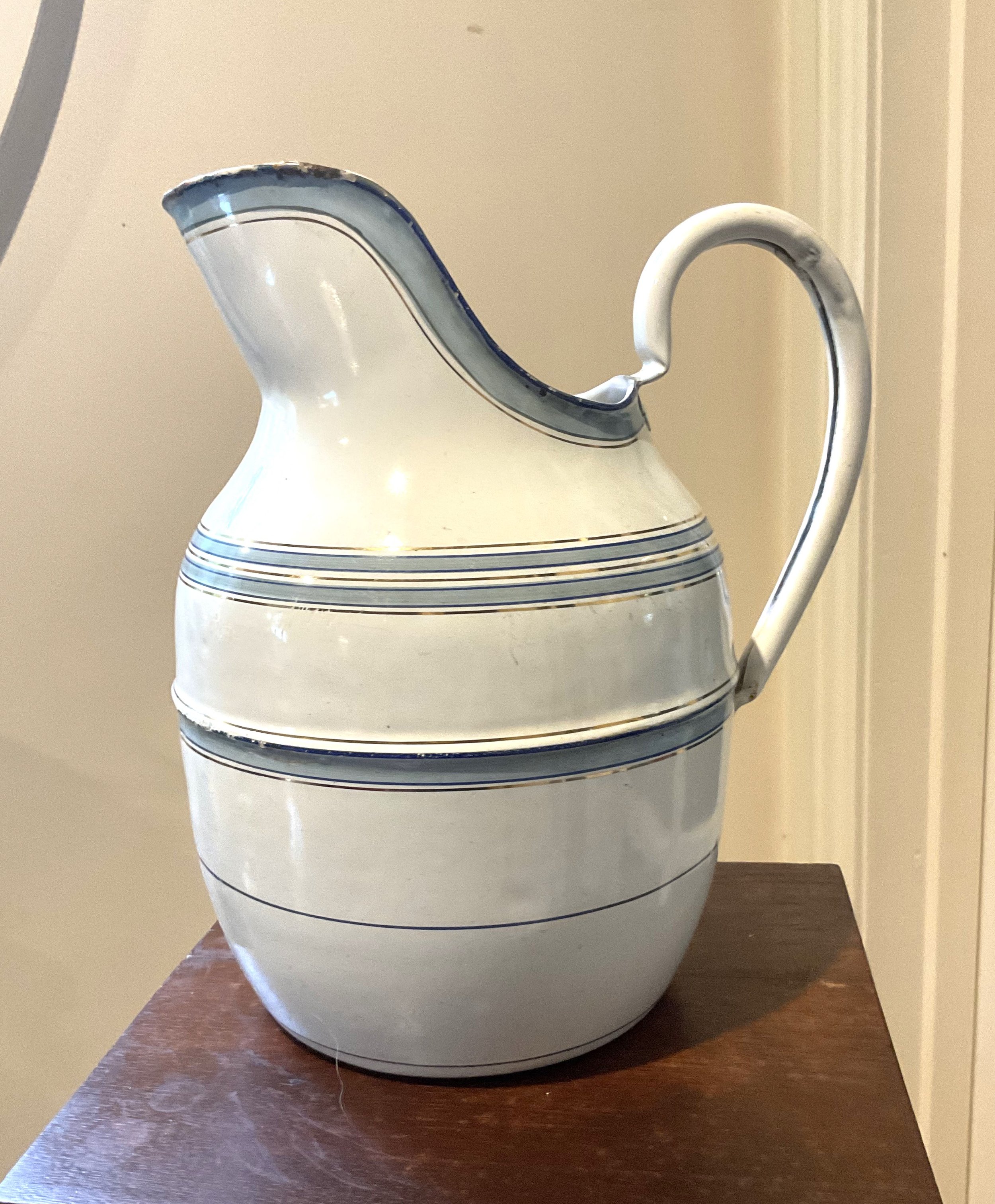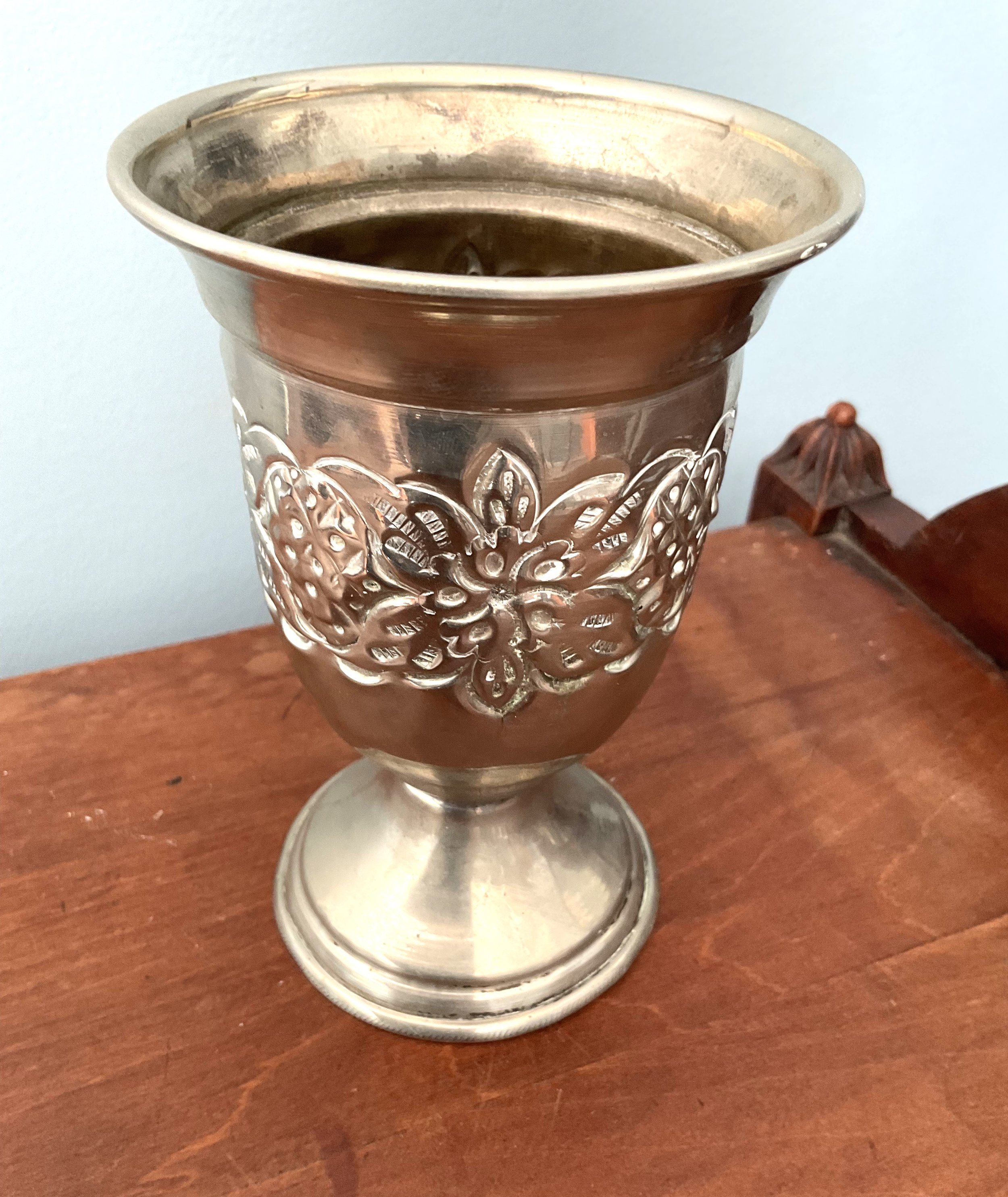 Image 1 of 6
Image 1 of 6

 Image 2 of 6
Image 2 of 6

 Image 3 of 6
Image 3 of 6

 Image 4 of 6
Image 4 of 6

 Image 5 of 6
Image 5 of 6

 Image 6 of 6
Image 6 of 6







French Antique Enamel Ware Jug And Basin
This gorgeous French antique enamelware basin is full of character. Circa 1870 from Payes de Loire I am sure it has many stories to tell. It features a blue hand painted design on a whie background.
French enamelware was painted functional steel or tin. Enamelware was mass produced in the late 1800s. It was produced throughout Europe, in Austria, Germany, Belgium and Czechoslovakia. Made by the fusion of powdered glass to steel using a firing process, it was tolerant to hot and cold. Once fired, the powdered glass melted and hardened to a smooth coating. Several coats of enamel were applied to produce a thick, glossy finish. Skilled metal workers made the wares. The pieces were fired and hand painted decoration was applied before the final firing, where the artwork became baked on. The decoration and graphic designs of many wares were painted by credible artists. This was considered a serious art form at the time. By the late 1930s, all details of the manufacturing process were done by machine. This included the stencilling artwork. Enamelware became highly popular in France. Wares such as pots, pans, sets of canisters, utensil racks, coffee pots, tea pots, kettles, sugar bowls, milk jugs, soap holders, scrubbing dishes, pitchers and bowls and much more were produced as enamelware. Another common enamelware item was the lavabo (a basin with a water tank). This was placed outside the back door. It was used for hand washing before coming inside after working in the garden or fields. Enamelware took pride of place in ordinary homes.
This enamelware jug and basin does have some damage due to the wear and tear of age and has been priced appropriately. The jug measures approximately 23 cms in height and 18 cms across. There is a small hole at the base of the jug. The bowl measures 32 cms across and 9 cms in height.
This gorgeous French antique enamelware basin is full of character. Circa 1870 from Payes de Loire I am sure it has many stories to tell. It features a blue hand painted design on a whie background.
French enamelware was painted functional steel or tin. Enamelware was mass produced in the late 1800s. It was produced throughout Europe, in Austria, Germany, Belgium and Czechoslovakia. Made by the fusion of powdered glass to steel using a firing process, it was tolerant to hot and cold. Once fired, the powdered glass melted and hardened to a smooth coating. Several coats of enamel were applied to produce a thick, glossy finish. Skilled metal workers made the wares. The pieces were fired and hand painted decoration was applied before the final firing, where the artwork became baked on. The decoration and graphic designs of many wares were painted by credible artists. This was considered a serious art form at the time. By the late 1930s, all details of the manufacturing process were done by machine. This included the stencilling artwork. Enamelware became highly popular in France. Wares such as pots, pans, sets of canisters, utensil racks, coffee pots, tea pots, kettles, sugar bowls, milk jugs, soap holders, scrubbing dishes, pitchers and bowls and much more were produced as enamelware. Another common enamelware item was the lavabo (a basin with a water tank). This was placed outside the back door. It was used for hand washing before coming inside after working in the garden or fields. Enamelware took pride of place in ordinary homes.
This enamelware jug and basin does have some damage due to the wear and tear of age and has been priced appropriately. The jug measures approximately 23 cms in height and 18 cms across. There is a small hole at the base of the jug. The bowl measures 32 cms across and 9 cms in height.
This gorgeous French antique enamelware basin is full of character. Circa 1870 from Payes de Loire I am sure it has many stories to tell. It features a blue hand painted design on a whie background.
French enamelware was painted functional steel or tin. Enamelware was mass produced in the late 1800s. It was produced throughout Europe, in Austria, Germany, Belgium and Czechoslovakia. Made by the fusion of powdered glass to steel using a firing process, it was tolerant to hot and cold. Once fired, the powdered glass melted and hardened to a smooth coating. Several coats of enamel were applied to produce a thick, glossy finish. Skilled metal workers made the wares. The pieces were fired and hand painted decoration was applied before the final firing, where the artwork became baked on. The decoration and graphic designs of many wares were painted by credible artists. This was considered a serious art form at the time. By the late 1930s, all details of the manufacturing process were done by machine. This included the stencilling artwork. Enamelware became highly popular in France. Wares such as pots, pans, sets of canisters, utensil racks, coffee pots, tea pots, kettles, sugar bowls, milk jugs, soap holders, scrubbing dishes, pitchers and bowls and much more were produced as enamelware. Another common enamelware item was the lavabo (a basin with a water tank). This was placed outside the back door. It was used for hand washing before coming inside after working in the garden or fields. Enamelware took pride of place in ordinary homes.
This enamelware jug and basin does have some damage due to the wear and tear of age and has been priced appropriately. The jug measures approximately 23 cms in height and 18 cms across. There is a small hole at the base of the jug. The bowl measures 32 cms across and 9 cms in height.
Not suitable for delivery via Australia Post. Collection by appointment. Please make contact if you would like to arrange another type of delivery. Free delivery to some Melbourne metropolitan areas can be arranged.

































